一、本期重点:
doi: 10.1126/science.1261243
published:2015.05.01
内容介绍:
对纳米尺度的光的研究已经成为一个充满生气的研究领域,例如研究人员现在能够控制光波远低于光波长的尺度,在很大程度上超过受衍射影响的传统光学限制。利用精确刻蚀在二维或三维纳米构筑内的金属和电介质纳米结构,可以实现对光的散射、折射、限制、滤波、以及其他使用自然材料和常规几何结构无法实现的新的处理方式。对光的这种纳米尺度的控制,不仅揭示了更多新的现象,也提供了许多相关应用,包括集成电路的新基底、光学计算、太阳能相关及医疗技术等,也对未来几年将迸发出的新发现充满期待。
文章介绍了光子晶体、表面等离子体激元、光学天线、压缩光及量子光子、压缩矢量场增加磁力和偏光力、材料及超颖表面、纳米尺度光场,综述了现有的一些实际应用,并对未来发展和前景进行分析与展望。
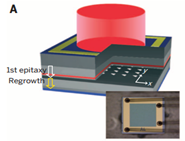
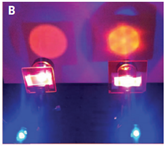
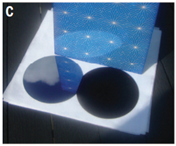
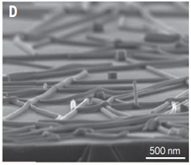
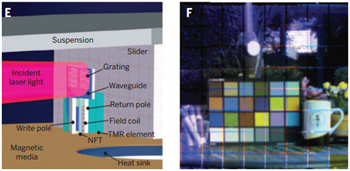
图一 纳米光子技术及应用 (A)高功率光子晶体激光器 (B)无(左)和有(右)由从嵌入式Ag纳米颗粒中散射光增强辐射的LED (C)太阳能电池中的黑色硅晶圆无(左)和有(右)用于增强光耦合及限制的电介质光学超颖表面 (D)由随机分布的化学生长单晶Ag纳米线制成的透明传导纳米线网 (E)带有等离子体共振光聚焦锥的热辅助记录磁头原理图 (F)由带有用于波长多路复用的集成等离子体纳米孔阵列的等离子体CCD芯片拍摄的图像
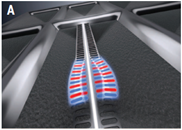
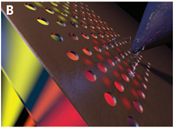
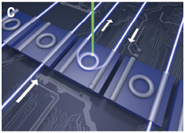
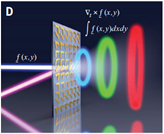
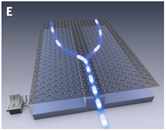
图二 纳米光子技术未来的挑战及研究领域 (A)混合纳米光子:光与其他自由度的耦合,如机械运动 (B) Plasmoelectric效应利用金属纳米结构将太阳光转化成电力 (C)非交互式光学集成电路使得光学计算逻辑函数成为可能 (D)电调谐光学超颖表面作为光通信网络波分复用器,且可进行模拟运算操作 (E)电调谐二维石墨烯光电子集成电路集合了光学和电学尺度
2.利用极紫外瞬态光栅的四波混频实验(Four-wave mixing experiments with extreme ultraviolet transient gratings)【Nature】
doi: 10.1038/nature14341
published:2015.09.09
内容介绍:
四波混频(FWM),基于三阶非线性的光与物质相互作用,能够将超快时间分辨率、能量和光矢量选择度结合在一起,使通过线性方法无法实现的动力学探究称为可能。FWM方法的相干和多波段性质在先进技术的发展中十分重要,例如硅光子学、亚波长成像和量子通信。所有这些技术在光波长尺度上进行操作,限制了空间分辨率且无法在电子伏特范围探测激发能量。扩展至更短的波长,即极紫外和软X射线范围,则能够提高空间分辨率和激发能量范围,同时通过利用核心共振保证基本的选择度。目前,在某些波段的FWM的应用已经因缺失足够亮度的相干光源及合适的实验装置而受到限制。本文展示了如何将由FERMI自由电子激光器提供的相干极紫外脉冲干涉产生的瞬态光栅,用于FWM在亚光学波长的激励。证明了观察FWM信号随时间演化的可能性,展示了随分子振动的相干动力学作用。这一结果为具有纳米空间分辨率和基本选择度的FWM打开了新的思路,例如,可以研究电荷转移动力学。实现这些应用的理论可能性已经激励了正在进行的自由电子激光器的发展:文中结果表明亚光学波长的FWM是可行的。
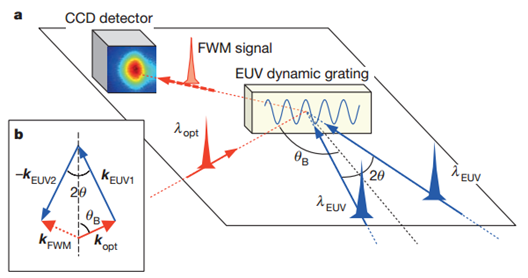
图三 利用EUV瞬态光栅的FWM实验-基于FEL的FWM实验原理图
二、简讯:
doi:10.1364/OL.40.003097
published:2015.6.25
Abstract:
We demonstrate, to our knowledge, the first on-chip heterodyne interferometer fabricated on a 300-mm CMOS compatible process that exhibits root-mean-square (RMS) position noise on the order of 2 nm. Measuring 1 mm by 6 mm, the interferometer is also, to our knowledge, the smallest heterodyne interferometer demonstrated to date and will surely impact numerous interferometric and metrology applications, including displacement measurement, laser Doppler velocimetry and vibrometry, Fourier transform spectroscopy, imaging, and light detection and ranging (LIDAR). Here we present preliminary results that demonstrate the displacement mode.
doi:10.1364/OL.40.003037
published:2015.06.22
Abstract:
Illumination design for extended sources is very important for practical applications. The existing direct methods that are all developed for extended Lambertian sources are not applicable to extended non-Lambertian sources whose luminance is a function of position and direction. What we present in this Letter is to our knowledge the first direct method for extended non-Lambertian sources. In this method, the edge rays and the interior rays are both used, and the output intensity at a given direction is calculated to be the integral of the luminance function of all the outgoing rays at this direction. No cumbersome iterative illuminance compensation is needed. Two examples are presented to demonstrate the elegance of this method in prescribed intensity design for extended non-Lambertian sources in two-dimensional geometry.
doi: 10.1364/OL.40.003009
published:2015.06.18
Abstract:
We present a practical spatial-domain interferometer for characterizing the electronic density gradient of laser-induced plasma mirrors with sub-30-femtosecond temporal resolution. Time-resolved spatial imaging of an intensity-shaped pulse reflecting off an expanding plasma mirror induced by a time-delayed pre-pulse allows us to measure characteristic plasma gradients of 10–100 nm with an expansion velocity of 10.8 nm/ps. Spatial-domain interferometry (SDI) can be generalized to the ultrafast imaging of nm to μm size laser-induced phenomena at surfaces.
doi: 10.1364/OE.23.016933
published:2015.06.19
Abstract:
In optical tomography, there exist certain spatial frequency components that cannot be measured due to the limited projection angles imposed by the numerical aperture of objective lenses. This limitation, often called as the missing cone problem, causes the under-estimation of refractive index (RI) values in tomograms and results in severe elongations of RI distributions along the optical axis. To address this missing cone problem, several iterative reconstruction algorithms have been introduced exploiting prior knowledge such as positivity in RI differences or edges of samples. In this paper, various existing iterative reconstruction algorithms are systematically compared for mitigating the missing cone problem in optical diffraction tomography. In particular, three representative regularization schemes, edge preserving, total variation regularization, and the Gerchberg-Papoulis algorithm, were numerically and experimentally evaluated using spherical beads as well as real biological samples; human red blood cells and hepatocyte cells. Our work will provide important guidelines for choosing the appropriate regularization in ODT.
供稿:师途







